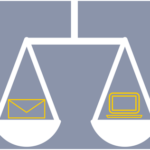July 9, 2015: Decades ago, the arrival of mail at home was an exciting event. Receiving a letter from a family member or friend touched our hearts, and we’d be “over the moon” if we were lucky enough to receive a love letter. But over the years something changed. The number of letters declined. More and more commercial mail packed our mailboxes. The term “junk mail” aptly described these unwanted intrusions.
With the advent of email in the early 1990s, and then, a few years later, near universal access to the Internet, most important communications went electronic, relegating our mailboxes to the role of a dusty repository for unwanted ads and bills. Consequently, it became fashionable to deride postal mail as an old-fashioned relic of a pre-Internet era.
But just as the pundits were proclaiming postal mail to be extinct, something extraordinary happened. A new generation arrived whose view of commercial mail is less negative than those of prior generations. Marketers became more creative, and more adept at personalizing direct mail so that it resonated with people on an individual level. The result is that direct mail is less junky, more appealing, and more effective than in years past. These assertions are borne out by new data from the DMA (Direct Marketing Association), which both point to direct mail’s continuing strength and to the winning tactics that smart mail marketers can use to make the arrival of mail in the home exciting again:
A less crowded mailbox. In 2008, the average American household received 24.7 mail pieces per week. In 2014, the mail count was down by 22.6 percent, to just 19.1 pieces a week. A lot of marketers — especially those engaged in national “saturation bombing” campaigns (remember AOL?) have left the market. That’s good news for marketers who want to stand out through hyper-targeting and personalization.
Postcard advertising is a proven marketing strategy. According to the DMA, 50.9% of recipients find postcards useful, making them the type of direct mail piece most favored by consumers. Postcard advertising remains popular today as a low-cost way to use direct mail. This form of advertising is easy to hold and view, and can be multi-purposed — from folded postcards that include more design and text; to single postcards not placed in envelopes so that the full advertisement is visible to the recipient at first glance. Postcard ads are particularly successful in industries such as real estate.
The direct mail newsletter is a community-driver. A newsletter is a bulletin issued to members of an organization or other group on a regular basis. This form of communication is of most value to community-oriented entities, such as libraries and fire departments. To capture your audience, a captivating newsletter should have the following characteristics:
• One-page newsletter. Most people have limited time nowadays to read anything, so keeping the newsletter to one page is important.
• Human interest. It’s helpful to highlight a personal story in your newsletter if possible. For example, highlighting a firefighter who received an award for a heroic act is a topic that will intrigue many people.
• Captivating design. Make sure to use lively colors and appealing images that will catch the eye.
• Keep it basic. Keep the language in the newsletter easily digestible with engaging headlines, concise paragraphs, and a bulleted or checklist format. Material that contains heavy copy and verbose language is often tossed in the garbage.
• Dimensional mail pieces. You can delight customers with dimensional mail that is clever and potentially inspires your target audience. Try sending something in a box, a tube, or a gift inside an interestingly-shaped envelope that recipients will notice. While dimensional mail campaigns are more costly than other forms of direct mail, they are highly effective.
• Sharing is caring. Particularly for non-profit organizations, sharing a profile about someone in need will often pull at the heart strings. These are important stories to tell – and it is a demonstrated way to interest donors and others to lend a hand.
Also, keep in mind, that it’s critical to test your direct mail campaigns. You need to go through the process and sometimes send ads multiple times, in different ways, to see what works and what doesn’t. Bottom-line, nowadays, because there’s less competition in the mailbox, now is the perfect time to make your offer or product stand out from the pack!

![By Stefan Bellini (Own work) [CC0], via Wikimedia Commons](https://www.diditdm.com/wp-content/uploads/2015/07/No_JunkMail_Valletta-1024x675.jpg)
![By Stefan Bellini (Own work) [CC0], via Wikimedia Commons](https://www.diditdm.com/wp-content/uploads/2015/07/No_JunkMail_Valletta.jpg)









![By Photograph: Frank C. Müller, Baden-Baden (Own work) [CC BY-SA 2.5 (http://creativecommons.org/licenses/by-sa/2.5)], via Wikimedia Commons](https://www.diditdm.com/wp-content/uploads/2015/08/opening-an-envelope-150x150.jpg)
![By User:Introvert (Own work) [CC BY-SA 2.5 (http://creativecommons.org/licenses/by-sa/2.5)], via Wikimedia Commons](https://www.diditdm.com/wp-content/uploads/2015/10/1024px-Sparkling-snow.sierra-150x150.jpg)